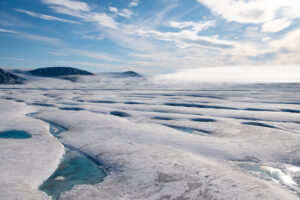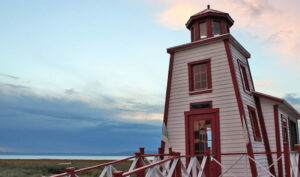
People & Culture
On thin ice: Who “owns” the Arctic?
As the climate heats up, so do talks over land ownership in the Arctic. What does Canadian Arctic Sovereignty look like as the ice melts?
- 4353 words
- 18 minutes
Travel
Navigating chunks of ice in frigid temperatures, Robin Esrock recounts his thrilling experience ice canoeing on the St. Lawrence River

Long before the existence of ferries and bridges (which would have made things significantly easier for traders and passengers), canoes were used to cross the St. Lawrence River every day of the year. Winter snow, ice, freezing rain and strong tides didn’t stop hardy canoers shuttling goods, mail, and even hospital patients from one shore to the other. This history is celebrated with a popular ice-canoe race at the annual Winter Carnival, drawing local sponsors, media coverage, and competitive teams from the United States and France. Crews train hard for the occasion, although strength and technique will only get you so far.
Unpredictable and treacherous winter conditions on the St. Lawrence River are the greatest adversity. Cheered by crowds, competitors push, scrape, smash, paddle and swim against the hostile elements, seemingly impervious to sharp ice and metal spikes that can splinter boat and bone. Glory and beer await the victors, extending a legacy that stretches back centuries. Founded by a former race organizer, tour operator Canot à Glace Expérience invites visitors to pick up a spiky paddle and give it a go. There will be waiver forms.

Quebec City in February is frigid, and I don’t need an ice bath to prove it. Bundled up, I meet my fellow paddlers at a blessedly heated launch area, where we are provided with neoprene boots and socks, a life vest, shin and knee guards, spiked paddles, and heavy-duty crampons. A veteran race guide demonstrates the peculiar technique of getting the canoe across the river, navigating chunks of hard ice along the way. One moment we’ll be rowing across fast-flowing water, the next requires us to quickly exit the canoe, stowaway our paddles, place one knee in the boat, and push the canoe forward with one leg, all in constant motion. This is called scootering, and if you do it incorrectly, you might slip, puncture a fellow paddler with your crampon, or crash through the ice.

Following instructions, we haul the long canoe to the icy edge. Shoving it forward would be easy on a lake or rink, but river ice is chopped, gnarly, jagged and thick enough to splinter wood. Our navigator must constantly adjust our direction to avoid hazards, a difficult task considering there are hazards everywhere you look. Once we push off, I instantly appreciate the kind of physical shape one needs to be in to do this sort of thing and that our pint-sized female guide has the strength of sixteen men. The official race does not discriminate between genders, and all-female teams are among the best outfits. Suddenly, the ice gives way, and I feel the shock of ice-cold water flood into my boots. Now we must transition into rowing mode, quickly hop into position, and, just in case I wasn’t getting enough exercise, heave our paddles against strong tides and slabs of ice. The fact that I’d given myself four out of five for fitness on the waiver form appears outrageously optimistic. Our spiked paddles often crack thin ice to enter the water, an effective reminder of how easily they can crack a skull if we’re not careful. Just as we get into a rhythm, we hit a hefty chunk of solid ice. Now we must hoist the canoe up, throw paddles in the middle and start scootering again. This lasts seconds or minutes, and suddenly we’re in the water again. The process repeats over and over again during the hour-long excursion, but since we’re not racing, there are plenty of rest breaks, hot chocolate, and opportunities to ask, not for the first time in my Canadian bucket list adventures: “how is this a thing?”

It reminds me of the 80s arcade game Frogger, where you had to hop from log to log to get across the river, only the logs kept disappearing. Our canoe is the frog, ice slabs are the logs, and everyone inevitably gets wet. Returning to shore on our round-trip adventure, we encounter a challenging ice sheet that almost capsizes our canoe. Fortunately, wood can take a lot more punishment than my nerves. Serves me right for joining a young crew eager to get their hands wet. Canot à Glace shapes each excursion to match the physical abilities of its guests, and while your own canoe race might be less strenuous, nobody should expect a tranquil boat ride. There are countless spots in Canada to row your boat gently down the stream. Most are not nearly as memorable as the thrill of ice canoeing in Quebec City.
Travel with us
Heli-hiking in the Cariboos with Robin Esrock
Perfectly placed within Canada’s ‘high country’, CMH Cariboos offers all the comforts of a well-appointed lodge in the middle of absolutely nowhere. With your Can Geo Ambassador, Robin Esrock, you will fly to remote viewpoints for the ultimate adventure as well as a day of travel and writing instruction.
Are you passionate about Canadian geography?
You can support Canadian Geographic in 3 ways:

People & Culture
As the climate heats up, so do talks over land ownership in the Arctic. What does Canadian Arctic Sovereignty look like as the ice melts?

Environment
What the collapse of the Milne ice shelf and the loss of a rare Arctic ecosystem might teach us about a changing planet

Travel
Following the St. Lawrence’s winding course through Quebec delivers a feast of history, culture and food

Science & Tech
Celebrating Canadian Innovation Week 2023 by spotlighting the people and organizations designing a better future